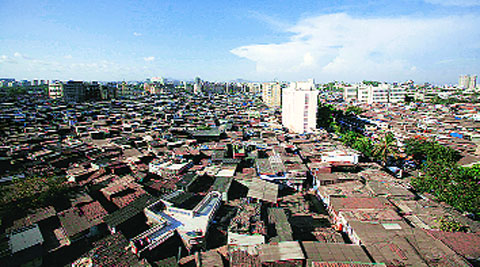- India
- International
It’s no solution to Mumbai’s slum problem
Sandeep Ashar and Stuti Shukla find out how the extension won’t quite help tackle the city’s slum problem.
 The Slum Rehabilitation Authority, an idea born during the saffron regime in 1996 to get rid of Mumbai’s slum problem, has been a dud thus far.
The Slum Rehabilitation Authority, an idea born during the saffron regime in 1996 to get rid of Mumbai’s slum problem, has been a dud thus far.
While the Prithviraj Chavan-led government has extended the cut-off date for slum regularisation to January 1, 2000, Sandeep Ashar and Stuti Shukla find out how the extension won’t quite help tackle the city’s slum problem. In fact, activists and urban planners feel the move is another attempt to cater to needs of the real estate
Just ahead of Lok Sabha elections, the Congress-led Democratic Front government in Maharashtra has extended the slum cut off date from January 1, 1995 to January 1, 2000. The move will confer legitimacy to an additional 3 lakh slum dwellers making them eligible for free rehabilitation. But will the extension help in getting rid of Mumbai’s mammoth slum problem?
Will it make Mumbai slum free?
Slum activists, urban planners and government officials are unanimous it won’t be of much help in achieving this goal. In fact, wary that the biggest beneficiary from the largesse will be slum redevelopment-driven real estate, town planners and urban activists whom Newsline spoke to are concerned of the implications the move would have on Mumbai’s outstretched infrastructure.
The slum problem
Official statistics reveal that every fifth person in Mumbai live in a slum household. As per the provisional findings of the 2011 census, about 52.07 lakh people out of a total population of 1.21 crore reside in slums.
The Slum Rehabilitation Authority, an idea born during the saffron regime in 1996 to get rid of Mumbai’s slum problem, has been a dud thus far.

Under SRA, slum dwellings, conferred legitimacy, are eligible for free rehabilitation in planned habitats. The cut-off date was January 1, 1995 previously. It has now been extended to January 1, 2000.
Mumbai had around 40 lakh slum-dwellers in 1996. The idea behind the SRA was to rehabilitate all of them. But in 18 years, the SRA has managed to move barely 1.53 lakh slum-dwellers. Only 99 out of the 1524 slum redevelopment projects have so far been completed.
Over 200 slum rehabilitation schemes approved are in the limbo. These include projects where builders have entered into agreement with the squatters, whereas another 1,100 are under various stages of redevelopment.
Even going by the 1995 cut-off, the number of eligible slum units was around 10.5 lakh. Its extension to 2000 has increased this by another 3 lakh. This means that over 13.5 lakh out of 27 lakh slum units – data is based on the 2010 household survey – has been granted legal cover.
Only four per cent of slum-dwellers eligible as per the 1995 slum cut-off date have been rehabilitated so far.
We look at reasons for the failure…
Builder-centric approach
Activists and urban planners feel a major reason behind SRA’s failure is the “government’s casual approach towards slums”.
Senior journalist Mahesh Vijapurkar, who writes extensively on Mumbai’s slum problem, feels that “instead of being seen as an issue, Mumbai’s slum problem is seen as a tool to cater to needs of the real estate”.
Over the years, the government has raised floor space index (FSI) to incentivise slum redevelopment for developers. The FSI is a ratio of built-up area to the total area of the plot.
Under current rules, a builder can utilise a minimum FSI of 3 for slum redevelopment projects in all areas that are not affected by coastal regulation zone norms. This simply means that for a 1000 sq m plot, the builder is allowed to construct a minimum of 3,000 sqm.
Further, in slums where the population density is high and the developer is unable to rehabilitate all the residents on the same plot, he is allowed to utilise the additional built-up area made available on another plot further north, in the suburbs. This is facilitated by generating Transfer of Development Rights (TDR) certificates for the developer, which are also tradeable.
It was this additional burden on the city’s infrastructure on account of the TDR, which made the Bombay High Court pass an order restraining the state government from extending the slum cut off beyond 1995.
While the government’s challenge to this restraint order is still pending with the Supreme Court, the government managed to secure the state’s legislature nod to a bill for extending the slum cut off. Chief Minister Prithviraj Chavan has said that the extension of cut off was a promise made by the DF alliance in its 2009 manifesto. His government now maintains that the infrastructure in Mumbai has been sufficiently beefed up to cope with the resultant burden.
But, even state functionaries concede that extension of cut off will not make Mumbai slum free. “It is more to bring stalled redevelopment projects back on track,” a senior government official said.
At a recent meeting, senior SRA officials said a majority of stalled redevelopment projects were the ones where the percentage of ineligible slum-dwellers was over 50 per cent.
In fact, slum activist Simpreet Singh feels “extension of cut off itself hampers effective implementation of slum redevelopment schemes.” He added, “Most slum colonies have a mix of eligible and ineligible residents. The ineligible ones often oppose redevelopment plans of the other group. Even before a developer emerges on the scene, an internal conflict has already arisen. By introducing a cut off, the government is only creating an unhealthy contest among slum dwellers in a slum.”
Even Amita Bhide, professor at the Centre for Urban Policy and Governance at the Tata Institute of Social Studies, said that introducing a cut off is flawed. “In a city where migrant and floating population is so high, we cannot have only ownership driven housing. In every slum, at least 30 percent families are excluded from the Slum Rehabilitation Schemes because they are not eligible due to some reason or the other. In such a scenario, why cant the city have adequate rental housing? This concept of extending cut-off dates repeatedly is merely a way for politicians to woo voters when they need to,” she says. Bhide feels “a more inclusive approach is the key to resolve the slum problem”.
A senior official acknowledged that the government is in a bind on how to handle cases of pre-2000 slum structures that were razed or declared ineligible for rehabilitation in an ongoing slum scheme.
At the ground level, slum dwellers are apprehensive. Fareed Hussain, resident of Cheetah Camp, the sprawling slum settlement in the Mankhurd-Mandala area, said that while residents are happy that their houses will now be legally protected, they are cynical about whether it will be implemented. “SRA tends to overlook a very important aspect, i.e the height of structures. SRA recognizes only the ground floor structure but 90 percent slums in Mumbai are at least ground plus one storey. The BMC does not issue photo passes to residents of structures more than 14 feet in height, but a ground plus one structure is at least 20 feet tall,” said Hussain. The nearby Maharashtra Nagar is one of the settlements largely affected by the recent decision as it has mainly come up between 1997-99.
Free housing versus Rajiv Awaas Yojna
Urban experts have denounced the idea of free housing. Simpreet Singh of the Ghar Banao Ghar Bachao movement said that free housing should be stopped to prevent squatting in the first place. “Rehabilitation tenements should be charged for, if not at market price, at least at lower rates,” he said. Former MHADA official and housing expert Chandrashekhar Prabhu said that such pre-election sops are doled out because of the slum dwellers’ greed to get free housing. “Demolition of slums as a norm has become rare of the years. Slum dwellers know that they enjoy protection from local politicians and are driven by the greed for free houses. This can lead to a rise in the number of slums,” he said.
The union government’s Rajiv Awas Yojna is being seen as a a possible alternative. It seeks to provide housing to all slum dwellers, without any cut-off dates, at a price. The state housing department is considering undertaking housing schemes and slum redevelopment under the RAY. As per the scheme, besides the state and central government’s monetary contribution, an illegal slumdweller also has to contribute to get pucca houses under the redevelopment scheme.
Inability to stop encroachments
Another pressing issue is the government’s inability to stop encroachments. “Large scale encroachment is happening on government land, especially mangrove and forest land, every single day by slum lords who enjoy protection from local politicians and officials.Large scale dumping of debris on wetlands, as means to reclaim land, is the first step of encroachment. Large tracts of mangrove land in Mankhurd-Mandala area are being encroached upon every day. The political game of extending cut-off dates will continue till the government does not put a strict barrier on new encroachments,” said Hussain. A former official from the SRA said, “300 persons come to Mumbai everyday from outside the city, without a place to live in here. Encroachments are thus a reality. But there has to be an end to the business of extending cut-off.”
Exclusion of slums from planned development
Even as more than half of the city’s population lives in slums, the BMC’s draft Development Plan (DP) for the next 20 years has left out these areas in its planning process. Moreover, slums falling under the Mumbai Metropolitan Region Development Authority (MMRDA) and the Special Planning Authorities (SPA) such as the Maharashtra Industrial Development Corporation (MIDC), have been left out of the planning process. Some of the areas which come under SPAs include Dharavi, one of the biggest slum clusters in the city.
Bhide said that extending legal status to slums is not enough. “Basic amenities and services such as water, education and health have to be extended to all. For this, planning is needed within slums,” she said.
Raising concerns over the exclusion of slums and its population in the future development plan, Pankaj Joshi, executive director of the Urban Design Research Institute, said: “While slums and the population continue to exert pressure on the city’s infrastructure, the BMC has failed to analyse the slums pockets in the DP. There is no strategy which has been recommended to incorporate holistic development of slums and special planning areas in the DP.”
The Gujarat slum rehab model
A major reason behind SRA projects being stuck in limbo is getting the mandatory consent from 70 per cent of residents of the slum settlement. In the existing scheme of things, residents choose the builder and builders choose the slums. “The scope of irregularities and manipulation by builders is wide in such a case. Gujarat developed its own slum rehabilitation policy on the lines of Maharashtra’s SRA in May last year but made one vital change-that of open bidding,” said Singh. Unlike the Maharashtra policy, where developers had to select slums for rehabilitation by getting consent of the dwellers, the Gujarat government invites bids for slum rehabilitation and awards contract through a bidding system. However, Gujarat has also capped the profits developers can make, which is not the case in Maharashtra. The developer bidding for lowest price for construction of units, and highest amount to the authority in lieu of free-held land, will be awarded contract for slum rehabilitation. It also allows developers to use transferable FSI for seven years and not beyond. Since May last year, 12 projects have been approved in Ahmedabad out of which work has begun on five projects.
sandeep.ashar@expressindia.com
stuti.shukla@expressindia.com
Must Read
Apr 23: Latest News
- 01
- 02
- 03
- 04
- 05






































